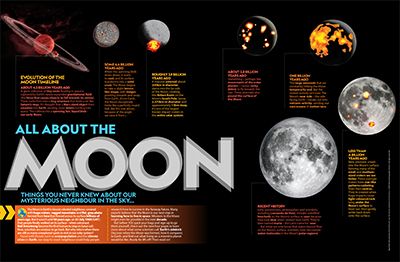
All about the moon primary resource
Blast off on a lunar adventure!
 This Science primary resource contains fascinating facts and detailed information about the moon. When and how did the moon form? How long is a lunar day? What lies below the moon’s surface? What would Earth be like without the moon…?
This Science primary resource contains fascinating facts and detailed information about the moon. When and how did the moon form? How long is a lunar day? What lies below the moon’s surface? What would Earth be like without the moon…?
Pupils will gain an in-depth understanding of the moon in this primary resource – from the history of this celestial body to the huge effect it has on our planet.
N.B. The following information for mapping the resource documents to the school curriculum is specifically tailored to the English National Curriculum and Scottish Curriculum for Excellence. We are currently working to bring specifically tailored curriculum resource links for our other territories; including South Africa, Australia and New Zealand. If you have any queries about our upcoming curriculum resource links, please email: schools@ngkids.co.uk
This Science primary resource assists with teaching the following Upper Key Stage 2 Science (Year 5) objectives from the National Curriculum:
Pupils should be taught to:
- Describe the movement of the Earth, and other planets, relative to the Sun in the solar system
- Describe the movement of the Moon relative to the Earth
- Describe the Sun, Earth and Moon as approximately spherical bodies
- Use the idea of the Earth’s rotation to explain day and night and the apparent movement of the sun across the sky.
Pupils should be introduced to a model of the Sun and Earth that enables them to explain day and night. Pupils should learn that the Sun is a star at the centre of our solar system and that it has eight planets: Mercury, Venus, Earth, Mars, Jupiter, Saturn, Uranus and Neptune (Pluto was reclassified as a ‘dwarf planet’ in 2006). They should understand that a moon is a celestial body that orbits a planet (Earth has one moon; Jupiter has four large moons and numerous smaller ones).
This Science primary resource assists with teaching the following Sciences Early level objectives from the Scottish Curriculum for Excellence:
-
I have experienced the wonder of looking at the vastness of the sky, and can recognise the sun, moon and stars and link them to daily patterns of life.
This Science primary resource assists with teaching the following Sciences Early level objectives from the Scottish Curriculum for Excellence:
-
By safely observing and recording the sun and moon at various times, I can describe their patterns of movement and changes over time. I can relate these to the length of a day, a month and a year.
This Science primary resource assists with teaching the following Sciences Second level objectives from the Scottish Curriculum for Excellence:
- By observing and researching features of our solar system, I can use simple models to communicate my understanding of size, scale, time and relative motion within it.
Download primary resource
More Like

Canada facts

5 wildlife photography tips!

Sonic Superstars









LEAVE A COMMENT
THANK YOU
Your comment will be checked and approved shortly.
WELL DONE,
YOUR COMMENT
HAS BEEN ADDED!
COMMENTS
Please explain why I can't register as a teacher. The page is asking me to provide registration details for a child and a parent also before it let's me click 'register' and I'm not registering as either of these.
CUSTOMIZE YOUR AVATAR